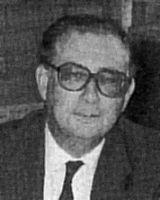


Letter from the President
Letter from the President

In Jan. of this year, Acta Crystallographica was enriched by a new section, Acta D: Biological Crystallography. The need for the new section became apparent as the rate of determination of new structures of macromolecular compounds grew to nearly one structure per day. This growth is also reflected in the increasing proportion of papers of biological interest being presented at IUCr Congresses which reached 20% at the XVth Congress in Bordeaux. Since other journals on molecular biology and proteins concentrate on the biological aspects, rather than crystallographic ones, there is a great need for a journal of this type. For these reasons, the Commission on Journals had suggested at the XVth IUCr Congress, in July 1990, that the possibility of launching a new journal in this field be studied. This was the first task undertaken by the new Executive Committee. After consultation with the Editorial Board of the J. of Molecular Biology, a working party was set up which met in early 1991. A number of options were studied, leading to the launching of Acta D, with J.P. Glusker, from the Inst. for Cancer Research, Philadelphia, PA, USA, as Editor. The new section has a bright, glossy color cover which gives a new look to Acta, and the same will be done in the future for the older sections. I am sure that Section D will be a great success, and I strongly encourage all those working in the field to submit papers to it.
On the day of the deadline, over 900 abstracts had already been submitted to the Programme Chairman of the XVIth Congress which will take place in Beijing in Aug. at the invitation of our Chinese colleagues, and this is particularly encouraging. The large attendance and the high scientific level of the Inaugural Congress of the Asian Crystallographic Association last Nov. in Singapore has shown how fast crystallography is developing in Asia, and it is very timely that the IUCr should hold its Congress in that region. It should be very interesting and stimulating.
The Ewald Prize will be awarded for the third time during the Opening Ceremony of the Congress. It will go to Prof. Norio Kato, former President of the IUCr. Prof. Kato's scientific work was very closely related to that of Ewald. Together with A. Lang, he observed fringes which N. Kato interpreted as Pendellösung fringes, in other words interference fringes between wavefields propagating in a crystal. This was one of the most important predictions of Ewald's theory of X-ray diffraction. The only difference being that Ewald's theory was applied to plane waves, while Kato showed that the real waves emitted by an X-ray tube were spherical waves. Kato's work was concerned not only with X-ray optics, so important nowadays in all the optical devices for beam conditioners and monochromators for synchrotron radiation, but also with extinction, which is of primary importance to all crystallographers determining a crystal structure. A particular cause for satisfaction is the report by the Ewald Prize Selection Committee of the large number of excellent candidates from which they had the difficult task of making a selection. If one remembers that Nobel Prize awardees are excluded, this shows what a big reservoir of top scientists there is among crystallographers!
André Authier, PresidentInternational Union of Crystallography


